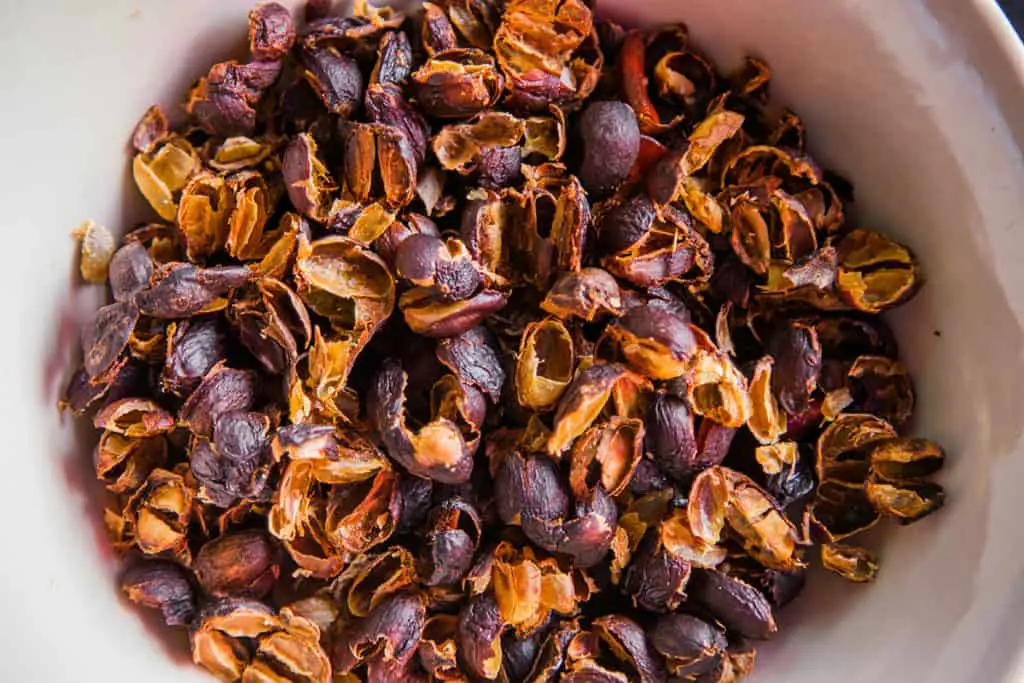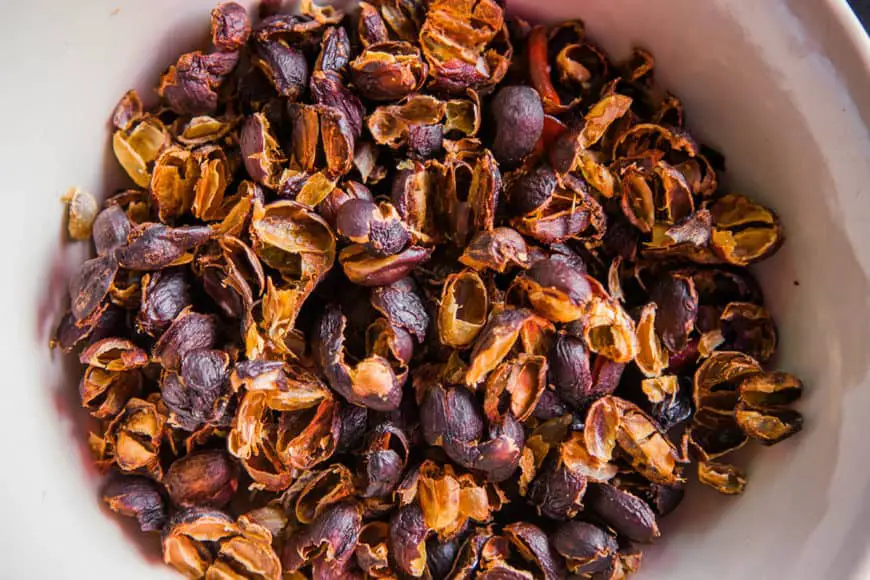
Cascara, also known as coffee cherry tea, is a beverage made from the dried skins of the coffee fruit, which is the fruit that surrounds the coffee bean. The word “cascara” means “husk” or “shell” in Spanish, which refers to the outer layer of the coffee fruit that is removed during the processing of coffee beans.
After the coffee beans have been removed, the fruit is usually discarded or used as compost. However, some coffee farmers have started to dry the fruit and sell it as a tea. Cascara tea has a sweet, fruity flavor and is often compared to a cross between black tea and hibiscus tea.
Where Does Cascara Come From?
The coffee fruit is grown in many countries around the world where coffee is produced, including but not limited to:
- Colombia
- Costa Rica
- El Salvador
- Ethiopia
- Guatemala
- Honduras
- Kenya
- Nicaragua
- Panama
- Rwanda
Coffee farmers usually discard the coffee fruit after removing the beans, but some have started to dry the fruit and sell it as cascara tea.
The popularity of cascara tea has grown in recent years, and it is now available in specialty coffee shops and online retailers in many parts of the world. Some coffee farmers have also started to use the dried coffee fruit as a natural fertilizer or animal feed.
How is Cascara Processed?
The process of producing coffee cascara typically starts with harvesting the coffee cherries either by hand or machine. After harvesting, the coffee cherry is separated into its components, and the outer skin and fruit pulp are removed from the inner coffee bean.
The resulting coffee cascara is then spread out on drying beds or patios to dry in the sun. Regular turning of the cascara is important to ensure even drying and prevent mold growth.
Once the coffee cascara is fully dry, it is sorted and cleaned to remove any unwanted materials.
What is the Difference Between Cascara Coffee and Tea
Cascara coffee and cascara tea are both made from the dried skin or husk of the coffee cherry fruit that surrounds the coffee bean. However, there are some key differences between the two.
Firstly, the way in which they are prepared is different. Cascara coffee is made by brewing the dried coffee cherry husk with hot water, much like making traditional coffee. In contrast, cascara tea is made by steeping the dried coffee cherry husk in hot water, much like making traditional tea.
Another difference between the two is in their flavor profile. Cascara coffee typically has a more complex and nuanced flavor than cascara tea, as it retains some of the flavor characteristics of the coffee beans that it was harvested from. Cascara tea, on the other hand, has a lighter and more fruity flavor, with notes of hibiscus or cranberry.
Finally, cascara coffee typically contains caffeine, while cascara tea does not. This is because the caffeine content of the coffee cherry husk is removed during the coffee bean roasting process. Cascara tea is therefore a caffeine-free alternative to traditional coffee.
How Much Caffeine in Casacara?
Cascara does contain caffeine but certainly not as much as tea or coffee. If we take regular coffee beans, for example, there is roughly 40mg of caffeine for every 100g of coffee, and you can expect to have about a quarter of this amount of caffeine in cascara coffee, even the strongest brewed cascara coffee won’t exceed this amount.
If you like to experiment with different flavors in your coffee, then you can try adding a little cinnamon, honey, nutmeg or something similar to give the drink a little twist. Don’t forget that cascara is fruity and sweet so only add extra flavorings a little at a time so as to not make it too sweet or overbearing.
What is the Best Way to Drink Cascara Coffee?
Since technically, cascara is neither a tea nor a coffee, many people are stumped as to how to prepare a cup but don’t worry because we have the only set of instructions you will ever need.
While the end result of cascara being ground down isn’t exactly the same as tea leaves, it is best to brew them in a similar way as you would tea leaves.
Place your coffee husks into a cup, the recommended amount is about 250g of water for every 18g of cascara coffee. After this, boil your water but keep an eye on the temperature. The perfect temperature for brewing coffee is said to be 205 degrees (Fahrenheit), however, for cascara, the optimum temperature is 190 degrees.
Once the water has reached this temperature, pour it into your cup, and let it brew for between three and four minutes. After, the coffee husks are now ready to be removed, and for this, you can use a tea strainer like you would with tea leaves. If you fancy making it a cold coffee you can pour the brewed drink over ice after you have removed the coffee husks.
What are the Health Benefits of Drinking Cascara?
Cascara tea is high in antioxidants and may have some health benefits, such as reducing inflammation and improving digestion. However, more research is needed to fully understand the potential benefits and risks of consuming cascara tea. It is also important to note that cascara tea contains caffeine, so it should be consumed in moderation and may not be suitable for individuals who are sensitive to caffeine.
Final Thoughts
Cascara coffee is a wonderful alternative to your morning brew, especially if you are trying to cut down on your caffeine consumption. Each day, cascara is becoming increasingly popular in places that until recently had never sold it, due to its exotic and refreshing flavor. Cascara is definitely one for you to try, so keep an eye out for it the next time you are in your local cafe, as it might just become your new favorite drink!


